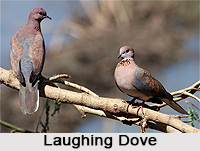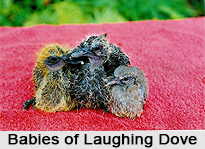 Laughing Dove is an Indian bird especially the breeder in Sub-Saharan Africa, the Middle East to the Indian Subcontinent. Laughing Dove is a migratory in nature.
Laughing Dove is an Indian bird especially the breeder in Sub-Saharan Africa, the Middle East to the Indian Subcontinent. Laughing Dove is a migratory in nature.
Description of Laughing Dove
Laughing Dove was described by Linnaeus who placed it in the genus Columba along with other pigeons. It was later placed in the genus Streptopelia but studies of molecular phylogeny indicated that this and the spotted dove stood out from the remainder of the Streptopelia species leading to the use of an older genus name that has been used for the species by Carl Sundevall.
Concentration of Laughing Dove
Laughing Dove is a small long-tailed dove that is found in dry scrub and semi-desert habitats where pairs can often be seen feeding on the ground. A rufous and black chequered necklace gives it a distinctive pattern and is also easily distinguished from other doves by its call. Other names include Palm Dove and Senegal Dove while in Indian states the name of the little brown dove is often used. It was introduced in Western Australia and has established itself in the wild around Perth and Fremantle.
Structure of Laughing Dove
Laughing Dove is a long-tailed, slim pigeon, typically 25 cm (9.8 in) in length. It is pinkish brown on the underside with a lilac tinged head and neck. The head and under parts are pinkish, shading to buff on the lower abdomen. A chequered rufous and grey patch is found on the sides of the neck and is made up of split feathers. The upper parts are brownish with a bluish-grey band along the wing. The back is uniform and dull brown in the Indian population. The African populations` senegalensis and phoenicophila have a bluish grey rump and upper tail coverts but differ in the shades of the neck and wing feathers while aegyptiaca is larger and the head and nape are vinous and upper wing coverts are rufous.
Tail of Laughing Dove
The tail of Laughing Dove is graduated and the outer feathers are tipped in white. The sexes are indistinguishable in the field. Young birds lack the chequered neck markings. The legs are red. The populations vary slightly in plumage with those from more arid zones being paler. Abnormal leucistic plumages have been noted.
Sounds of Laughing Dove
The chuckling call of Laughing Dove is a low rolling Croo-Doo-Doo-Doo-Doo with rising and falling amplitude
Habitat of Laughing Dove
Laughing Dove is a common and widespread species in scrub, dry farmland and is habitat over a good deal of its range, often becoming very tame. The species is found in much of Sub-Saharan Africa, Saudi Arabia, Iran, Afghanistan, Pakistan and India. It is also found in Israel, Lebanon, Syria, the UAE and Turkey. They are mostly sedentary but some populations may make movements. Birds ringed in Gujarat have been recovered 200 km north in Pakistan and exhausted birds have been recorded landing on ships in the Arabian Sea.
Behaviour of Laughing Dove
Laughing Dove is usually seen in pairs or small parties and only rarely in larger groups. Larger groups are formed especially when drinking at waterholes in arid regions. Small numbers assemble on trees near waterholes before flying to the water`s edge where they are able to suck up water like other members of the pigeon family. Laughing Doves eat the fallen seeds, mainly of grasses, other vegetable matter and small ground insects such as termites and beetles. They are fairly terrestrial, foraging on the ground in grasslands and cultivation. Their flight is quick and direct with the regular beats and an occasional sharp flick of the wings which are characteristic of pigeons in general.
 Courtship of Laughing Dove
Courtship of Laughing Dove
The male Laughing Dove in courtship display follows the female with head bobbing while cooing. The male pecks its folded wings in "displacement-preening" to solicit copulation from the female. A female accepts by crouching and begging for food. The male may indulge in courtship feeding before mounting and copulating. Pairs may preen each other. Males may also launch into the air with wing clapping sounds and then glide down in a gentle arc when displaying.
Nests of Laughing Dove
The nest of Laughing Dove is a very flimsy platform of twigs built in a low bush and sometimes in crevices or under the eaves of houses. Both parents build the nest with males bringing the twigs which are then placed by the female.



















